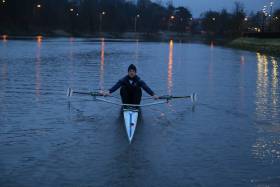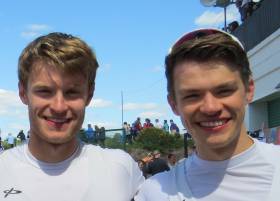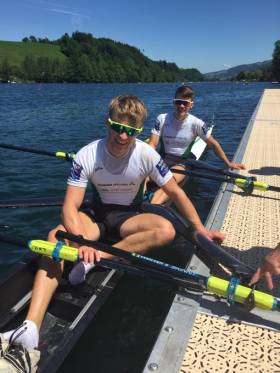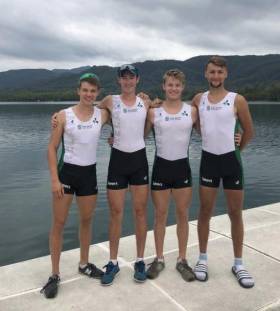Displaying items by tag: Jake McCarthy
Gary O'Donovan Tenth Overall at World Rowing Championships
#Rowing: Ireland's Gary O'Donovan took fourth in his B Final of the lightweight single sculls at the World Rowing Championships in Linz-Ottensheim.
Rainer Kepplinger of Austria won, with O'Donovan part of group close behind. The finish puts O'Donovan 10th overall here.
Alice Arch of Australia won the women's lightweight single, with Ireland's Lydia Heaphy fifth. Heaphy had led through the first quarter.
The Ireland lightweight quadruple took second to the United States in their B Final.
World Rowing Championships, Linz-Ottensheim, Day Six (Irish interest)
Men
Lightweight Quadruple - B Final: 1 United States 6:03.94, 2 Ireland (H Sutton, M Taylor, R Ballantine, J McCarthy) 6:06.62.
Lightweight Single - B Final (places 7 to 12): 1 Austria (R Kepplinger) 7:00.16; 4
Ireland (G O'Donovan) 7:02.18.
Women
Lightweight Single - B Final (places 7 to 12): 1 Australia (Alice Arch) 7:52.59; 5 Ireland (L Heaphy) 7:55.40.
#Rowing: The Ireland pair of Mark O’Donovan and Shane O’Driscoll just missed out on a qualifying for the quarter-finals at the World Rowing Championships in Austria today.
The Skibbereen men had to be in the top two in their repechage, but in a three-boat finish, Chile pipped Greece and Ireland were just .66 of a second off qualifying. They go to the E Final.
The lightweight quadruple of Hugh Sutton, Miles Taylor, Ryan Ballantine and Jake McCarthy finished fourth in their heat and will compete in a repechage as they attempt to make the A Final. Italy were very strong and won well, staying clear of Denmark and Austria. Italy qualified for the A Final.
World Rowing Championships, Linz, Austria, Day Two (Irish interest)
Men
Pair - Repechage Two (First Two to Quarter-Finals; Third to Final E): 1 Chile 6:43.70, 2 Greece 6:43.71; 3 Ireland (M O’Donovan, S O’Driscoll) 6:44.35.
Lightweight Quadruple – Heat One (Winner to A Final; rest to Repechage): 4 Ireland (H Sutton, M Taylor, R Ballantine, J McCarthy) 6:04.84
Irish Crews Progress to A Finals at World Cup Regatta
#Rowing: Ireland took three A Final places from their first three races at the World Cup Regatta in Rotterdam this morning.
Philip Doyle and Ronan Byrne, the Ireland men's double, won their race. They took the lead and held it right through. Germany were their closest challengers, while Australia One finished well to to take the third qualification place.
The Ireland women's pair of Monika Dukarska and Aileen Crowley and lightweight single sculler Gary O'Donovan also qualified for A Finals.
The pair took the race to the other crews and led at 1500 metres. Spain and Romania covered the final 500 metres with real pace, but while Romania passed Ireland to win, Dukarska and Crowley came home ahead of Spain, who took the third qualification spot.
Gary O'Donovan finished fast in the semi-final to take second. He had been third for much of the contest. However, Jake McCarthy fell just short, taking fourth. He is set for a B Final.
#Rowing: Gary and Paul O'Donovan, the world champions in the lightweight double, won a key race at the Ireland trials today. Fintan and Jake McCarthy were two lengths behind the O'Donovans with 400 metres to go, but tightened it to a length on the line. The trials go on, with tests of different combinations.
Conditions at the National Rowing Centre were remarkably good.
Fifth in A Final for McCarthys at European Rowing
#Rowing: Ireland’s lightweight double of Fintan and Jake McCarthy took fifth in the A Final at the European Rowing Championships in Lucerne. Germany won gold, fighting off Italy and Belgium, who took silver and bronze. The Skibbereen twins were sixth through 500, 1,000 and 1500 metre marks, but lifted themselves to fifth in the final quarter, closing fast on Spain, who took fourth by .65 of a second from Ireland.
Earlier, Ireland's Sanita Puspure had taken gold in the women's single sculls.
European Championships, Lucerne, Day Three (Irish interest)
Men
Double Sculls – B Final (Places 7 to 12): 1 Germany 6:19.30, 2 Lithuania 6:19.44, 3 Italy 6:22.64, 4 Ireland (P Doyle, R Byrne) 6:22.81
Lightweight Double Sculls – A Final: 1 Germany 6:12.58, 2 Italy 6:13.95, 3 Belgium 6:15.51; 4 Spain 6:18.42, 5 Ireland (F McCarthy, J McCarthy) 6:19.07.
Women
Lightweight Double Sculls – B Final (Places 7 to 12): 1 Netherlands 7:05.12; 6 Ireland (D Walsh, L Heaphy) 7:22.38.
Single Sculls – A Final: 1 Ireland (S Puspure) 7:23.18, 2 Switzerland (J Gmelin) 7:24.04, 3 Czech Republic (M Topinkova Knapkova) 7:24.85; 4 Austria 7:25.03.
#Rowing: The McCarthy twins, Jake and Fintan, took their place in the A Final of the lightweight double sculls at the European Rowing Championships in Lucerne today. They slotted into third place in their semi-final, almost level with Spain after both crews had chased the winners, Germany. The Czech Republic missed out in fourth.
The Ireland women’s lightweight double of Lydia Heaphy and Denise Walsh took sixth in their semi-final and go the the B Final.
European Championships, Lucerne, Day Two (Irish interest)
Men
Double Sculls – Semi-Final One (First Three to A Final; rest to B Final): 1 Netherlands 6:11.71, 2 Britain 6:12.61, 3 France 6:13.81; 4 Ireland (P Doyle, R Byrne) 6:14.37.
Lightweight Double Sculls - Semi-Final One (First Three to A Final; rest to B Final): 1 Germany 6:16.29, 2 Spain 6:17.83, 3 Ireland (F McCarthy, J McCarthy) 6:17.97; 4 Czech Republic 6:18.78.
Lightweight Single Sculls – C Final (Places 13 to 17): 1 Austria (R Kepplinger) 7:09.42; 4 Ireland (G O’Donovan) 7:18.11.
Women
Lightweight Double Sculls – Semi-Final Two (First Three to A Final; rest to B Final): 1 Switzerland 6:55.47, 2 Italy 6:55.92, 3 Romania 6:56.25; 6 Ireland (D Walsh, L Heaphy) 7:18.75.
McCarthys Shine at European Rowing
#Rowing: Jake and Fintan McCarthy produced a brilliant final sprint to take a place in the semi-finals of the lightweight double sculls at the European Rowing Championships in Lucerne today. Just two crews would go through, and Italy led the way. The world silver medallists stayed ahead of a tight pack of challengers, with Ukraine closest as they came to the line. But the McCarthy twins upped their rate and pushed Ukraine out of a qualifying spot by a quarter of a second.
Lydia Heaphy and Denise Walsh, a new crew, did very well to qualify directly for their semi-final. They took the third and final qualifying spot in their heat. Switzerland and Britain fought it out at the head of the field, with Ireland holding off Spain and Sweden.
European Championships, Lucerne, Day One (Irish interest)
Men
Double Sculls – Heat One (First Two to A/B Semi-Finals; rest to Repechages): 1 Ireland (P Doyle, R Byrne) 6:26.53, 2 Romania 6:29.62.
Lightweight Double Sculls – Heat Two (First Two to A/B Semi-Finals; rest to Repechages): 1 Italy (S Oppo, P Ruta) 6:14.73, 2 Ireland (J McCarthy, F McCarthy) 6:16.07; 3 Ukraine 6:16.32.
Lightweight Single Sculls – Heat One (First Two to A/B Semi-Finals; rest to Repechages): 1 Italy (M Goretti) 7:05.54, 2 Switzerland (J Schaeuble) 7:06.73; 6 Ireland (G O’Donovan) 7:34.73.
Women
Single Sculls – Heat Three (First Two to A/B Semi-Finals; rest to Repechages): 1 Ireland (S Puspure) 7:30.65, Britain (V Thornley) 7:35.35
Lightweight Double Sculls – Heat Three (First Three to A/B Semi-Finals; rest to Repechages): 1 Switzerland 6:57.58, 2 Britain 6:58.61, Ireland (D Walsh, L Heaphy) 7:14.55.
Ireland Rowers On Pace but Out of Medals in Italy
#Rowing: Ireland crews contended in four A Finals on Sunday in the Memorial Paolo d’Aloja in Italy. There were two close-up fourth places: the lightweight men’s double of Jake McCarthy and Fintan McCarthy lost bronze to Portugal in the closing stages of their race, while the novel four of Tara Hanlon, Sanita Puspure, Aifric Keogh and Monika Dukarska fought to prevent a 1-2-3 of Romania crews in their race but missed out. The four of Claire Feerick, Emily Hegarty, Aileen Crowley and Claire Lambe were fifth.
Philip Doyle and Ronan Byrne were on the pace in the men’s double, but finished fifth, while Cliodna Nolan and Lydia Heaphy took sixth in the lightweight women’s double sculls.
Memorial Paolo d’Aloja, Piediluco, Italy, Finals (Irish results; selected)
Saturday
Men
Double – A Final: 3 P Doyle, R Byrne 6:33.90.
Lightweight Double Sculls – A Final: 3 F McCarthy, J McCarthy 6:38.43.
Women
Pair – A Final: 5 A Keogh, M Dukarska 7:33.3; 7 A Crowley, E Hegarty 7:42.36. B Final: 3 C Feerick, E Lambe 7:45.41.
Lightweight Double – A Final: 6 C Nolan, L Heaphy 7:48.91.
Single – A Final: 1 S Puspure 7:58.89.
Sunday
Men
Double Sculls – A Final: 5 P Doyle, R Byrne 6:41.56.
Lightweight Double Sculls – A Final: 4 F McCarthy, J McCarthy 6:45.55.
Women
Four – A Final: 4 T Hanlon, S Puspure, A Keogh, M Dukarska 7:05.53; 5 C Feerick, E Hegarty, A Crowley, E Lambe 7:06.98.
Lightweight Double Sculls – A Final: 6 C Nolan, L Heaphy 7:57.33.
Ireland Lightweight Quad Fifth in the World
#Rowing: Ireland’s lightweight quadruple of Fintan McCarthy, Ryan Ballantine, Jake McCarthy and Andrew Goff took fifth in the A Final of the World Championships today. Germany raced well, winning a contest with Italy, who took second. Turkey, Ireland and Denmark fought it out for the bronze. The Turks took the honours, while Denmark’s fast finish pushed Ireland back to fifth in the world.
Men
Lightweight Quadruple – A Final: 1 Germany 5:51.21, 2 Italy 5:52.85, 3 Turkey 5:53.95; 5 Ireland (F McCarthy, R Ballantine, J McCarthy, A Goff) 5:56.64.
Double – Semi-Final One (First Three to A Final; rest to B Final): Britain 6:06.59, 2 New Zealand 6:08.00, 3 Romania 6:08.17; 5 Ireland (P Doyle, R Byrne) 6:10.95.
Women
Eight – Repechage (First Four to A Final): 4 Britain (8 R Shorten) 6:04.63.
Single Sculls – A/B Semi-Final (First Three to A Final; rest to B Final): 1 Ireland (S Puspure) 7:23.01, 2 Denmark (F-U Erichsen) 7:30.73, 3 Germany (A Thiele) 7:32.74.
Ireland Lightweight Quadruple Qualifies for World Rowing Final
#Rowing: Ireland’s lightweight quadruple of Fintan McCarthy, Ryan Ballantine, Jake McCarthy and Andrew Goff secured an A Final place at the World Rowing Championships in Plovdiv, Bulgaria, this morning. They took the second and final qualification place in their repechage. Turkey and Ireland showed they meant business right through the race, with only Algeria and then Norway showing signs of being able to upset this leading order. Turkey were excellent in the second half of the race, moving over a length clear of Ireland, who were content to find their way to the final.
World Rowing Championships, Plovdiv, Bulgaria, Day Four (Irish interest)
Lightweight Quadruple Sculls – Repechage One (First Two to A Final): 1 Turkey 5:51.12, 2 Ireland (F McCarthy, R Ballantine, J McCarthy, A Goff) 5:54.09




























































